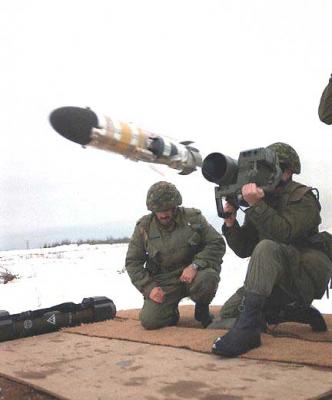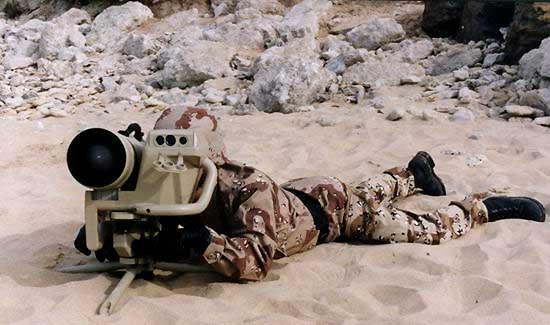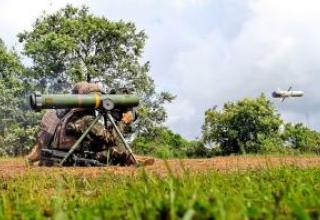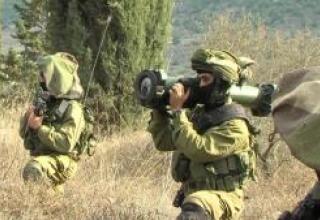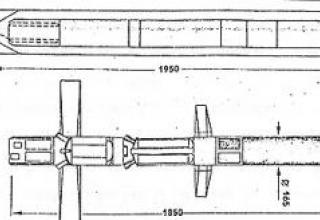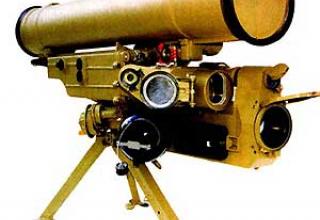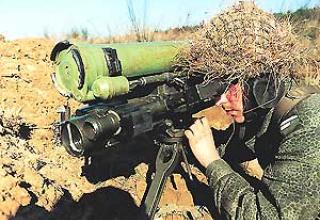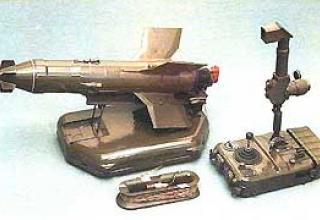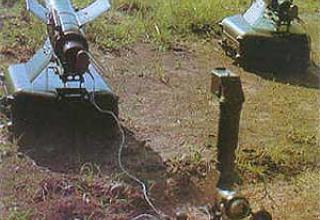According to some NATO experts, classical close combat anti-tank weapons, such as the LRAG and Apilas grenade launchers, do not meet the effectiveness requirements. This is due to the constant improvement of tanks, in particular, the increase in their maneuverability and mobility, strengthening the armour protection through the creation of new types of armour (composite, active, reactive).
According to the specialists of the Aerospatiale company (France), high efficiency of fighting tanks at short ranges in modern conditions can only be ensured by using guided missiles designed specifically for this purpose. In improving the characteristics of the grenade launchers, the limit has been reached on increasing the effective range, especially on moving targets (no more than 300 m), increasing armour penetration, reducing weight and dimensions.
In 1981, Aerospatiale launched a programme for the development of the PTUR, which was to ensure reliable hitting of tanks with new armour types at a range of up to 600 m at their frontal speed of up to 45 km/h and to be able to use it from areas of limited volume (when operating in populated areas).
The new wearable anti-tank complex, designated "Eryx", complements the Milan and HOT anti-tank systems and is intended for armament of compartments and platoons.
One of the main tasks faced by the developer was to ensure acceptable cost of the complex. This was achieved by optimizing the characteristics and designs, selection of components and materials, use of already used standard parts and devices. The cost of "Eryx" rocket is 1/3 of the cost of "Milan" PU, and the cost of PU is 7 times less than that of "Milan" complex.
The decision to adopt the complex in service with the French Army was taken in 1985.
Composition:
The complex consists of:
- a missile placed in a transport and launch container (TLC);
- Launching device (MU) with guidance device mounted on a tripod-lafette.
The following items are mounted on the trigger: optical sight with 3x magnification, IR goniometer, matrix IR target coordinator and fast microprocessor. Matrix target coordinator of "Thomson-CSF" company has a field of view of 8° x 6° and is made on CCD. For night-time firing, it is equipped with French Sopelem OB50 sight or sight with residual light amplification. The system can be easily carried by one person.
The plastic TPK contains: a transport container, a power supply unit and a device for docking to ground equipment, an embossing motor unit (VDU). A pyrotechnic battery is used as a power source.
Aiming the missile at the target is carried out automatically, from the operator it is required only to hold the crosshairs of the sight at the target until the meeting with the missile. PTUR "Eryx", equipped with an IR tracker on laser diodes, is tracked during the entire flight by the PU guidance device and with the help of remote control commands is automatically brought to the line of sight. The commands are transmitted to the missile via a wired communication line. The PU makes it possible to shoot from a "standing" or "kneeling" position, and with the help of a tripod machine it is possible to shoot from a "lying" position. After the missile is launched, the container is removed from the launcher and a new TPK with the missile is installed instead.
- Distinctive features of "Eryx" complex are:
- Equipping the missile with a tandem BC, effective when acting on the rocket armor, while the layout of the missile is made on an unconventional scheme: The main accumulator charge with a diameter of 135 mm is located in its rear part, which provides an optimal focal blast distance (3.5 caliber) and its effectiveness on target, and the marching engine - in the front of the rocket so that the nozzles are near the center of gravity of the rocket, which allows you to control the rocket with a thrust vector with increased accuracy and maneuverability at a close distance from the PU at low speeds of the rocket. The tandem BC preloader is located in the main compartment of the missile, the cumulative jet of the BC main explosive charge passes through a special channel in the center of the engine;
- the presence of an IR goniometer and a matrix receiver on the CCD, tracking IR-xenon tracer on laser diodes placed in the tail of the missile, operating in the wavelength range of 0.9 µm, which increases the performance of the missile in conditions of fog, smoke and interference;
- the missile's low muzzle velocity (17-20 m/sec), provided by an embossing propulsion system (AEU) installed in a transport and launch container and containing 80 g of propellant charge, allows the missile to fire from a confined space, which is very important for fighting in urban environments; the main solid propellant engine starts operating at a safe distance for the operator (10 m);
- wide use of microelectronic circuits in the design of the PU and the hardware unit of the PTUR.
The advantages of the "Eryx" APC compared to the grenade launchers are the doubling of the effective range and expanding the combat conditions, the high probability of hitting a moving target in the side wind (up to 10 m/s), and the high potential for further improvement. The probability of hitting a moving target at maximum range is 0.86 for a moving target and 0.9 for a fixed target.
The missile has a built-in technical condition monitoring system, which allows to quickly detect malfunctions. Operators are trained on the simulator without training firing. The control system is characterized by high noise immunity. Great attention was paid to ergonomic characteristics when choosing the design of the complex.
Characteristics:
| Range of fire, m | 25-600 |
| Maximum flight speed, m/s | 280 |
| Average flight speed (at a range of 600m), m/s | 158 |
| Initial flight speed, m/s | 17-20 |
| Missile flight time at a range of 600 m, s. | 3.8 |
| Missile flight time at a range of 300 m, s. | 2.6 |
| Missile launch overload, g | 30 |
| Guidance System | team semi-automatic PLC, IR goniometer, matrix receiver on CCD. |
| Onboard radiator | IR Xenon tracer on laser diodes |
| Tracer wavelength range, µm | 0.9 |
| Motor unit | VDU + marching RDTT |
| The length of the rocket, mm | 895 |
| Rocket caliber, mm | 152 |
| Length of TPK, mm | 940 |
| TIC outside diameter, mm | 162 |
| Weight of the complex with tripod, kg | 15.8 |
| Mass of TPC with rocket, kg | 11.0 |
| Mass of the rocket, kg | 9.8 |
| PU weight with guidance device and telescope sight, kg | 3.4 |
| Weight of tripods, kg | 1.45 |
| Mass of charge TPU, kg | 0.08 |
| Fighting unit | tandem cumulative |
| Maximum charge diameter, mm | 135 (main), about 25 (additional) |
| Weight BC, kg | 3.6 |
| Armor-piermeable, mm | 900 mm per ERS (normal, homogeneous steel plate) |
Testing:
During tests, ERINT missiles have repeatedly achieved direct hits to attacking ballistic missiles. During one of these tests, which took place on March 15, 1999, the second and third stages of the Minuteman-2 ICBM were destroyed by a direct hit.
According to the creators of the ERINT rocket, it is capable of destroying ballistic missiles with a range of up to 1000 km, including those equipped with chemical warheads.
Sources:
- Army Technology - Eryx - Heavy Anti-Armour Missile
- М. Растопшин "Особенности развития зарубежных ПТРК", "Техника и вооружение ",N 1, 2002.
- Armada International, 1990, №2, PP. 22-34.
- International Defense Review, 1989, V.22, №12, PP. 1631-1634.
- Armada International, 1987, № 4, PP.81-86.
- Armee et Defense, 1984, № 63, P. 22.
